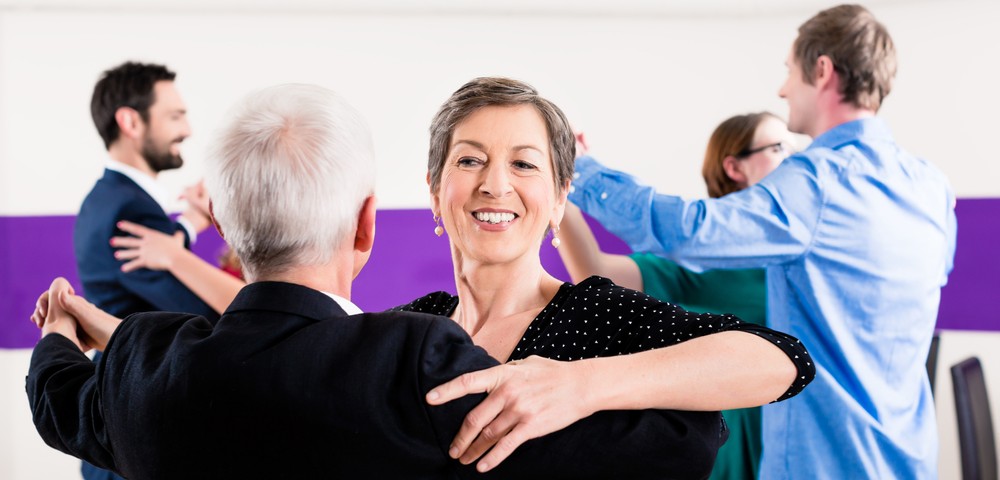Be the Dancer and Be the Artist

Would you — a person with Parkinson’s — ever call yourself a dancer? An artist? Graceful? Well, it’s possible. Be open to the idea. You may be surprised. I certainly was.
Recently, I met David Leventhal, the program director of Dance for PD. The program brings together trained dancers who are experts at moving alongside people with Parkinson’s who face movement challenges. Elements of dance addressing balance, gait, coordination, flexibility, isolation, depression, and other challenges of Parkinson’s are neatly interwoven throughout the entire class experience.
After a wonderful adventure on the subway, I arrived at the studios of the Mark Morris Dance Group in Brooklyn, New York, and waited for class to begin. I had seen videos of the program. I had also watched a documentary called “Capturing Grace,” which featured many of the dancers with Parkinson’s. Yes, dancers.
I would like to call myself a dancer. Thanks to weekly dance lessons with my husband, I am familiar with ballroom dancing, line dancing, etc. However, to say I am an artistic dancer is really stretching it. Hoping I would not draw attention to myself in the class, I settled on a seat near the back.
“When the dance class is going on, there are no patients … only dancers.” – Reggie, dancer, “Capturing Grace.”
The theme of the class was one of clay or dough. We reached, pulled, and used many variations of movement. With each movement, I was realizing that this program targeted Parkinson’s while also teaching artistry and grace.
Some movements were big and made with amplitude while others were intentionally small. There were also variations in speed — some were fast, others were slow. However, at the same time, all of our movements made a statement. We were moving with a purpose. As the pianist played the music, there were crescendos and decrescendos. Our bodies responded with movements that were unintentionally choreographed perfectly.
Our dough became bread through a series of movements. We tore our imaginary bread and passed it to others around the room in a way that reflected how we felt. There were big, sweeping movements from one person who in turn gently reached and passed it to the next.
Next, it was time to move around the room during a segment using body language to invite each other to dance, and then it was time to waltz. I was excited. I knew how to waltz. However, there was an added element of pushing and pulling the hands and arms of my partner. This introduced an element of balance and being in touch with my body to have a connection with my partner.
Graceful is not a word I would use to describe myself. Yet, I found myself gliding, switching partners, and waltzing around the room. Together, the group transformed into a graceful, moving work of art.
We ended the class in a circle, passing our dough into the hands of the person beside us. Each pass was different and had its own expression. I was last to pass my dough to the teacher, David Leventhal. It was a pass of gratitude and thankfulness. I spent an hour with people I had never met but shared their experience of dancing as art. It was obvious that our Parkinson’s didn’t matter. It made each one of us unique and that was reflected in our movements and the art we created.
“One thing I’ve come to believe about Parkinson’s is that it’s a disease of subtraction. It takes things from you one by one. And one of the many things I learned from the people in the class is that if you are confronted with a disease of subtraction, you better believe in addition. You better start adding things back into your life.” –Dave Iverson, producer, “Capturing Grace.”
I do believe that Parkinson’s can add things to life. Good things. You may have to look for them but they are out there somewhere. Like the dancers I met in class, for me dance has been one addition to offset the many subtractions.
What will be yours?
***
Note: Parkinson’s News Today is strictly a news and information website about the disease. It does not provide medical advice, diagnosis or treatment. This content is not intended to be a substitute for professional medical advice, diagnosis, or treatment. Always seek the advice of your physician or another qualified health provider with any questions you may have regarding a medical condition. Never disregard professional medical advice or delay in seeking it because of something you have read on this website. The opinions expressed in this column are not those of Parkinson’s News Today or its parent company, Bionews Services, and are intended to spark discussion about issues pertaining to Parkinson’s disease.







Comments